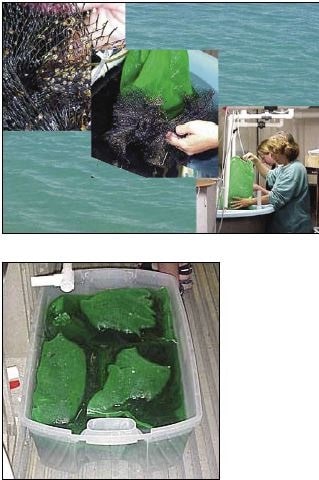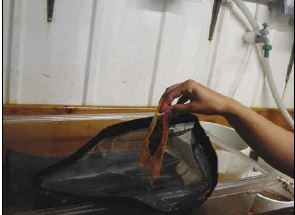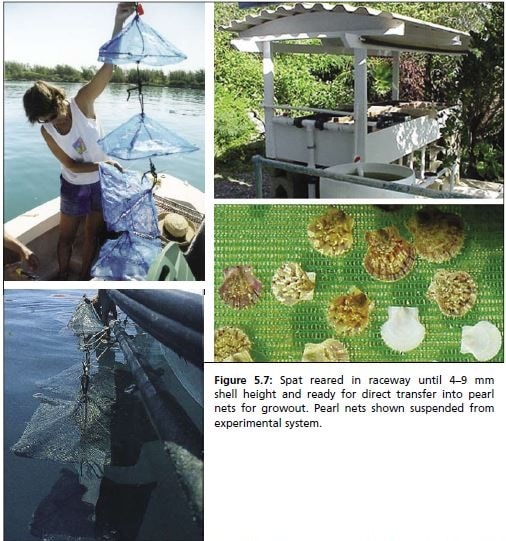5.2 TECHNIQUES – TRANSFER OF SPAT FROM NURSERY TO FIELD
As two methods for set are used at the BBSR nursery (see Chapter 4), and resulting spat are transferred to the growout sites at different stages, procedures in transfer differ. Spat transferred, following the rapid approach set, are younger and smaller. They are more fragile than those transferred from the raceway system mainly due to their age. Although, success has been obtained in using the natural environment as growout site for young spat, survival rate has been enhanced when spat are reared to a larger size prior to transfer.
5.2.1 Transfer of 1.5 mm spat from 450 litres tank set
Spat set in 450 litres tanks on cultch are transferred to the field when a shell height of 1.5 mm is reached, or approximately 1 month after set (Figure 5.3). As these are very small and can be easily lost or damaged during handling, care is taken to always keep the spat submerged. Cultch is transferred to green collector bags and held in a container filled with ambient saltwater for transport to the growout sites (Figure 5.4).
As outlined in detail in Protocol–16, green collector bags are suspended on longlines using scallop trays. Bags are inserted, one per tray, and trays are stacked one into the other in groups of six (Figure 5.5). The number of trays used in one stack is dependent on water depth, floatation of line, and equipment used for retrieving trays.
In Bermuda, all growout handling is done by hand with a small (9 m) outboard motor boat; it is found that as scallops grow and fouling accumulates on trays, groups of six are easiest to handle.

Figure 5.3: Transfer of one month old calico scallop spat in green collector bags for transfer to growout trays.
Figure 5.4: Spat pouches held in seawater prior to transfer to the field.
On-site, trays are secured using a 15 mm rope, wrapped around the entire set, in a similar manner to a gift-wrap package. A bridle coming from each corner of the stack ties in the middle to a stainless steel clip. The clip attaches directly to the longline. Other methods can be used for securing a series of trays, dependent on preference of the grower. Transfer of green collector bags to trays, and securing the trays is done quickly on-site, to minimize the time period in which spat are exposed to the air. Trays are thereafter left for a period of 6 weeks in the field. For collecting of spat, trays are

Figure 5.5: Securing of pouches into trays for growout in the field on longlines.
dismantled in the field, collector bags with spat are transferred to containers filled with seawater and transported to the nursery. Upon arrival at the nursery, bags are placed in running seawater in exterior tanks or in 450 litres tanks. Spat are collected by removing mesh from cultch, and shaken into plastic trays filled with seawater. Spat at this time are passed onto a large mesh sieve (3 mm) and distributed by weight to pearl nets. For 3 mm pearl nets, a total of 150 spat (average of 7 mm shell height) are grown for a period of one month. This approximates 23 grams wet weight.
PROTOCOL–16
TRANSFER AND RETRIEVAL OF SPAT ON CULTCH TO FIELD
1. Prepare cooler or other container for transport on boat to growout site. Clean with fresh water and fill with ambient seawater.
2. Load boat with scallop trays, cut rope for securing, clips and tools. Prepare top trays with bridles and clips (see Figure 5.5).
3. Place green collector bag in 450 litres set tank and, with cultch remaining submerged in tank, transfer gently to collector bag. Fill collector bag to approximately 2/3. Close collector bag with drawstring.
4. Carefully transfer collector bag to transport container.
5. Repeat procedure until all cultch is removed from 450 litres tank.
6. Carry transport container to boat and fill to rim with ambient seawater once on board.
7. Immediately travel to growout site.
8. Upon arrival, prepare 7 trays; bottom tray should have a weight secured for stability (use twine or cable ties for securing 2.5 kg weight). Top tray has ready-made bridle. Begin transfer of green collector bag to tray: place one bag on tray, stack second tray on top, add one collector bag, and stack another tray, etc., until 6 trays have been filled with collector bags.
9. Add top tray with bridle.
10. Wrap rope around stack as for a gift-wrap.
11. Clip tray onto longline.
12. Leave for growth for a period of 6–8 weeks.
13. When ready for collecting and sorting, prepare outdoor tanks or 450 litres with clean seawater. Return to site with transport containers.
14. On-site, remove tray stack. Dismantle and transfer green collector bags to transport container filled with seawater.
15. Upon arrival to hatchery, transfer bags to prepared tanks.
16. For removal of spat, prepare trays with flowing seawater; place bags in tray and remove cultch, shaking off and picking spat.
17. All collected spat is left in trays.
18. Pour water and spat into 3 mm sieve to collect all spat.
19. Sample 150 spat on mesh, blot dry and weigh.
20. Transfer to pearl net.
21. Weigh out sub-samples of same weight for transfer to pearl nets.
22. Maintain pearl nets in flowing seawater (exterior tanks or 450 litres) until transfer to the field.
23. For transport of nets to growout sites, hold nets in containers filled with seawater. Pearl nets are attached in series of six, dependent on water depth, floatation and method of retrieval. Keep at least 1 m distance between last net and seabed.
24. Nets are hung on longline using clips or by a secure knot.
5.2.2 Transfer of 2–4 mm spat from raceway to longlines
Procedures for spat set in the raceway and transferred to the field at a size too small to be placed directly into 3 mm pearl nets (2-4 mm) is similar to that described in Section 5.2.1 above. Care is taken not to damage the spat and to maintain them continually submerged during transfer. As they are too small for 3mm pearl nets, insert pouches made of window fly screen material are used as inserts into scallop trays (Figure 5.6). This material is of larger mesh size than the collector bags, allowing for increased seawater flow for larger spat, and reduces the degree of clogging by fouling. Pouches are rectangular in shape with dimensions similar to that of the tray; pouches are sewn on three sides; the fourth side is closed using Velcro for ease of opening and closing. Spat are collected from the sieves as outlined previously. A sub-sample of 400 spat is weighed in a first instance; thereafter, aliquots of similar weight are taken and distributed in each pouch. Remainder of transfer is conducted as described from step 6 on in Protocol–16. The older and larger the spat at transfer from the nursery to the field, the shorter the time period required for growth to 7 mm (and ready for growout in pearl nets).
For raceway spat, transferred approximately two months after set, an intermediate growout period of one month is usually required in trays. Following this intermediate growout phase, spat are retrieved from the field and brought to the nursery for assessment of survival, and are re-distributed into 3 mm pearl nets.

Figure 5.6: Transferring 2–4 mm spat into fly-screen pouches used as inserts for growout trays.
5.2.3 Transfer of spat >4 mm
Spat reared in the raceway for a longer time period, whether it is in the indoor or outdoor system are ready to be transferred directly to 3 mm pearl nets. The larger the spat become, the easier they are to collect, and the more tolerant they become to handling. Nonetheless, care is still taken to minimize air exposure during handling. Spat from all sieves are pooled. An initial sub-sample of 150 spat is weighed; once the

Figure 5.7: Spat reared in raceway until 4–9 mm shell height and ready for direct transfer into pearl nets for growout. Pearl nets shown suspended from experimental system.
weight is known, spat are distributed into pearl nets by weight. This is more time efficient than counting spat per net. For calico and zigzag spat, sub-samples of 23 grams resulted in approximately 150 spat per pearl net. Once spat are distributed, pearl nets are closed and held in flowing seawater until transfer to the field. In Bermuda, pearl nets are usually prepared one day, prior to transfer to the field. On the day of transfer, nets are transported in containers filled with seawater. On site, nets are tied in series of six or seven and connected to the longline using a clip or simply tied. Spat are left in 3 mm pearl nets for a period of one month.